Both the artwork and the video recording above are reflections based upon my memories of a now vanished forest which once stood near the home of my aunt, uncle and cousins. The present views of this area are captured via Google Earth and show the relative development of highways, neighborhoods, asphalt streets and concrete bridges, all expected elements of urban modernization (or "progress"). You would not ever know today what once was there if you had never seen the forest which enveloped this area back in the 1950's and 1960's. Perhaps this kind of development is symptomatic of many areas due to population density and the necessity of arterial roadways to alleviate traffic congestion. But it is a sad loss to those of us who love the green belt areas and hold fond memories of this particularly lovely woodland retreat. On my You Tube channel I have posted a series of accordion improvisations entitled "Baltusrol Impressions" which further explores my memories and reflections of this now vanished forest.
|
An improvisation based upon childhood memories of playing with my cousins Sharon and Kerry in Springfield, New Jersey at the western edge of Baltusrol Avenue where once there was a large forest with rocks, a stream and a stone bridge. Although my family did not live in Springfield, we often visited there allowing Sharon and Kerry to show me so many of the local attractions and scenery. I once stayed at my aunt and uncle"s house for a week affording plenty of time to explore the forested area adjacent to the neighborhood. My dad and I helped to extend Sharon and Kerry's house toward the back with a new kitchen and renovated dining room. So we were there for many weekends both working and relaxing. My cousins invited me to attend the Strawberry Festival in the springtime, held at Jonathon Dayton High School. We also saw the fireworks display in July and attended birthday parties, anniversaries and outdoor picnics at the Baltusrol Avenue address. In the years from 1955 to 1965 I came to love the forested area, the rock formations and the lyrical stream which meandered through the forest realms just a short walk from my relative's home. Sometime around the late 1960's or early 1970's this area changed drastically with the introduction of a new highway system which obliterated the forest and permanently altered the landscape which we as children had so dearly loved. This music is dedicated to my cousins Sharon and Kerry and to my Aunt Lill and Uncle Del for their warmth, hospitality and generosity of spirit in sharing their home and neighborhood with me. It is an improvisation which celebrates the innocence of children and the playfulness of the creative mind. This music reflects upon the pageantry of outdoor activities, the dance of one's inner spirit, and the breathless beauty of taking delight in four changing seasons. Both the artwork and the video recording above are reflections based upon my memories of a now vanished forest which once stood near the home of my aunt, uncle and cousins. The present views of this area are captured via Google Earth and show the relative development of highways, neighborhoods, asphalt streets and concrete bridges, all expected elements of urban modernization (or "progress"). You would not ever know today what once was there if you had never seen the forest which enveloped this area back in the 1950's and 1960's. Perhaps this kind of development is symptomatic of many areas due to population density and the necessity of arterial roadways to alleviate traffic congestion. But it is a sad loss to those of us who love the green belt areas and hold fond memories of this particularly lovely woodland retreat. On my You Tube channel I have posted a series of accordion improvisations entitled "Baltusrol Impressions" which further explores my memories and reflections of this now vanished forest.
0 Comments
Variations on a Swedish tune entitled "Christmas Day," from "Wee Sing for Christmas," published by Price, Stern, Sloan and collected and arranged by Pamela Conn Beall and Susan Hagen Nipp. I have added some improvisational elements to these variations, in both tempo and melodic line, allowing for an eclectic mix of styles and expressive moods. Performed upon the Hohner musette accordion, a 4/5 reed instrument in LMMM configuration.
This tune also appears in "Wee Sing - More Bible Songs" as "Father Noah" with different lyrics by Nancy Klein set to the same Swedish melody. I like variations because they permit the musician some creative potential in which to rearrange musical elements and present new ways of hearing familiar songs. This Hohner musette accordion allows for a wide variety of different reed voices to change the atmosphere, tempo and texture of each variation. Until recently I have not had access to a local pipe organ, but I would like to hear similar variations on that instrument as well. One of the strengths of the Hohner is the richness of the bassoon register which permits almost a Jazz-like flavor to the music. The musette tuning is especially popular in Europe and Latin America as well as in American folk music. This is an improvisational poem performed on my vintage 1930's Hohner Regina VI. In honor of someone I met many years ago while working a summer job, on a break from college, after the spring semester and looking onward toward the fall season. Along with this music, I send my heartfelt prayers and fondest thoughts to someone I never fully knew.
Inspired by listening to the many splendid instruments of Aristide Cavaille-Coll, the masterful builder and visionary whose influence is still being felt today. The recent release of "The Genius of Cavaille-Coll" from Fugue State Films illustrates in spectacular fashion the abiding interest in these fabulous treasures of musical art. Many thanks to Will Fraser, Simon Still, and David Hinitt for providing the world with a first-class review of the Cavaille-Coll legacy. Although I still love visual art and cherish the delights of poetry, I believe that music may be the best means of expression for things which may otherwise remain intangible or inexpressible. This improvisation was inspired by listening to the great pipe organs built by Aristide Cavaille-Coll (1811-1899), one of the most visionary and influential figures in the history of music. Other influences include the music of Cesar Franck (1822-1890), Frederic Chopin (1810-1849), and Franz Liszt (1811-1886). Performed upon my vintage 1950's Iorio accordion, a 4/5 reed instrument in LMMH configuration. The impressionistic character of this music reflects back upon a wilderness hiking trip I enjoyed many years ago in the State of Arizona. With some friends I traveled just north of Tortilla Flat and found a remarkable canyon which allowed a steep descent to the rocky floor below. We clambered down the angular incline and found a series of huge boulders amid the cool desert scenery. There were pools of stagnant water left behind after a recent spate of rain, and the canyon walls became orange reflections in the deep blue-green waters. A small stream fed manifold patches of brilliant green lichen and colorful moss. The air was clear and breathtaking as we looked up at the high canyon walls, perhaps as high as 400 to 500 feet. Everywhere we walked there echoed an immense and satisfying silence, except for the buzz of busy insects and curious flying birds. We came upon a perfectly flat rock in the middle of the canyon and stopped to have lunch and admire the beauty of this exotic place. When we had traversed the entire length of the canyon, we started to hike back up to the road, being careful not to disturb the cactus or other flowering plants. It was a breathtaking climb but a glorious sight to look down upon the entire length of wilderness we had just traveled through. This assortment of photographs gives a fairly representative selection of the views and scenery which can be seen at this location. The area is approximately 1.5 miles north of Tortilla Flat, on the east side of the road with minimal space for parking a vehicle. You can spend quite a long time in the canyon and surrounding territory, so it is best to start early on your hike, wear comfortable shoes and appropriate clothing, pack a good lunch or nutritious snack, bring plenty of water and travel with at least one experienced companion. The steep climb down the canyon provides a breathtaking view of the enormous size of this remarkable landscape. As you travel along the corridor of the canyon floor, you look up and see the incredible heights above glowing in shades of orange, tan, grey or pastel green. Sometimes the canyon looks like a blue and purple sunken temple of rocks and palatial boulders. Toward the southern end the views open up considerably and you can again appreciate the expansive panoramas afforded by an ambitious day-hike in Arizona. In musical terms, I am often reminded of "The Sunken Cathedral" by French composer Claude Debussy or even Joseph Jongen's "Symphonie Concertante" from 1926, a brilliant work for organ and orchestra. My own improvisation offers a more lyrical reflection upon this remarkable landscape, hence the title "Lyric Poem for Vintage Iorio Accordion." I hope to tour other geographical areas in Arizona to gain further artistic and musical perspectives from this rather fascinating State.
This is Part III of the recently posted series of improvisations entitled "Baltusrol Impressions." In this impressionistic piece, I am remembering some of the childhood experiences I enjoyed between 1955-1965 at the west end of Baltusrol Avenue while visiting my cousins in Springfield, New Jersey. This area is now completely urbanized, no longer featuring the extensive forest, stream, waterfalls and rocks which once stood where Route 24 presently stands. Traces of this kind of natural environment may still be seen at Briant Park to the northwest, Meisel Avenue Park to the south, or throughout South Mountain Reservation just outside of Millburn and South Orange. Watchung Reservation also exhibits similar characteristics. Part III continues the exploration of the Baltusrol Avenue environment, focusing upon the majesty of Winter, the icy splendor of the forest, the dance and swirl of snowflakes, and moments which I would call a seasonal symphony of grace. I remember the grand ice sculptures we once encountered, where the normally flowing waterfalls had frozen over in dozens of spectacular forms and shapes, like pieces of modern art strewn about on dazzling display. There also was a small pond which froze over and seemed hidden away in the rustic confines of the woods. Thousands of trees marked this area, signposts of a natural majesty which at times could take your breath away. The piece begins with a choral introduction at 00:10, celebrating our initiation of adventures within the forest realm. At 00:20 there is a song of prayer, an affirmation of life and a spirit of thankfulness. At 00:49 variations introduce us into the halls of this natural environment. At 1:56 there is an intimation of the grey, wintry majesty of the forest with the celestial sky above. At 02:16 there are hallmarks of children's games. A minor key section occurs at 02:54, where wistful remembrances paint a somber portrait. At 03:34 a dance enters the scene, reflective of the disparity between urban life and the natural environment. The conclusion of this dance occurs between 05:38 and 05:45, where there is a shift from the minor key back to the major. At 05:49 the triumphant theme returns, a hymn of praise in which I quote briefly from memory a small refrain from the great hymn "All Creatures of Our God and King." The return of joy occurs at 06:50, with dreams and a sense of happiness. At 07:24, a development of the noble theme transpires, with the grandeur of physical and spiritual sight and the fullness of expression taking form at 07:42. The last chordal section develops at 08:15, with the fundamental bass notes carrying the end of the day. Performed on my vintage 1950's Iorio accordion, an instrument with unique tonal capabilities, at times resembling the sonorities of a large pipe organ. As I play these improvisations, I can hear the sound of Cavaille-Coll in my mind, heart and spirit. My cousins Sharon and Kerry invited me to spend a week in Springfield, New Jersey at their spacious home along Baltusrol Avenue, a wonderful invitation back in the 1950's or 1960's. This was the beautiful home of my Aunt Lill and Uncle Dell, a place our family visited often for birthdays, anniversaries, outdoor picnics or Holidays like Christmas and New Year's Day. Sharon and Kerry asked if I had ever seen the forest and rocks and waterfalls at the end of the street where the trees became too numerous to count. I answered that I had never seen that area, whereupon they quickly gave me the grand tour and introduced me to the beauty of the forest. I think that this first impression must have occurred somewhere around 1955 when I was 8 years old. Many times we went there to disappear into the verdant vastness, imagining that the rocks were our forest fortress or lyrical, tree-lined palace. A gentle stream meandered through the woods, at times becoming a petite pond after churning through an incredible array of rocky formations. You could hold your hand in the water to feel the power and strength of the stream's consistent current. In the winter months, the snow and ice would cover the ground and almost bury the sound and active flow of the stream. Yet you could hear the water beneath the ice and sometimes spot areas where the water again surfaced from the icy crust above. It was a kind of paradise for us, a place where the seasons could be measured in textures, colors, sounds and earthy fragrance. My cousins invited me to attend Springfield's "Strawberry Festival" in the warmer months, held at the spacious grounds of Jonathan Dayton High School. When we had occasion to visit the forest again, the impressions struck the senses with renewed impact. My father helped to remodel my aunt and uncle's house by converting the old kitchen into a dining room and extending the kitchen into a newly constructed room at the back of the house. I helped to lay the tile in the dining room, and felt completely at home in this attractive and well-appointed residence. In the winter months we enjoyed the fireplace, in the summer months we loved the backyard and the gathering of relatives. If my cousins had not invited me to see the forest, I never would have known it was there. To them I owe a debt of gratitude. The word "vicarious" comes into play: "Felt or undergone as if one were taking part in the experience or feelings of another." My cousins drew me to a place which they found to be enormously beautiful. I quickly agreed with them and acknowledged their willingness to share such a delightful natural treasure. The joy of others can profoundly impact the drift of our lives and re-arrange the pattern of our experience. What once was obscure or unknown to me became a place of refuge and a signpost of my youth. It would of course be a great blessing to hear this improvisation on a large pipe organ, but the accordion is all I have. So I have tried to make the best use of it, recorded on a Canon SD 1000 digital camera. Currently I am using a better camera, a Sony DSC RX100. The last time I saw the forest was probably in 1965, but I remember this place so distinctly and with great detail. I remember my dad telling me in the late 1950's or early 1960's that the highway system possibly would be expanded and the forest removed along with the waterfalls and rocks. Some of us thought that surely something would be preserved, but that was not possible apparently. Today you would not know that anything like a forest was ever there. But through the gift of music, I can still visit that woodsy landscape and take delight in the pleasures of a now forgotten forest. 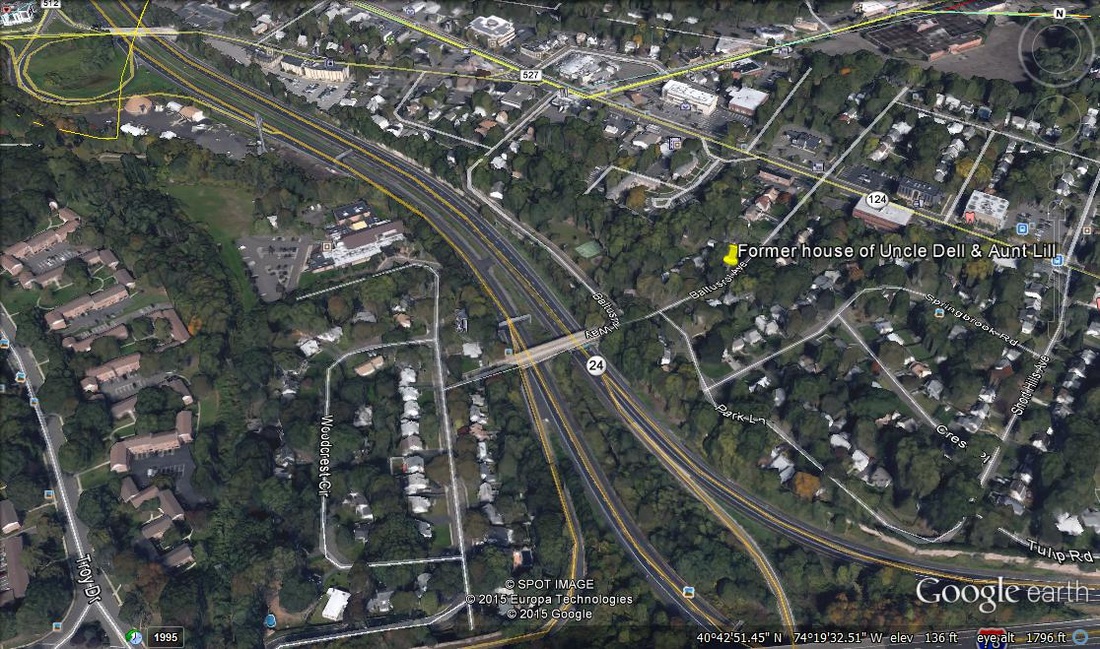 Aerial view from Google Maps which shows present day Baltusrol Avenue in Springfield, New Jersey. The yellow marker shows where my aunt and uncle's house stood, and the area in the central portion of the photo shows where the forest once stood. From a Joni Mitchell song: "You don't know what you've got till it's gone!" 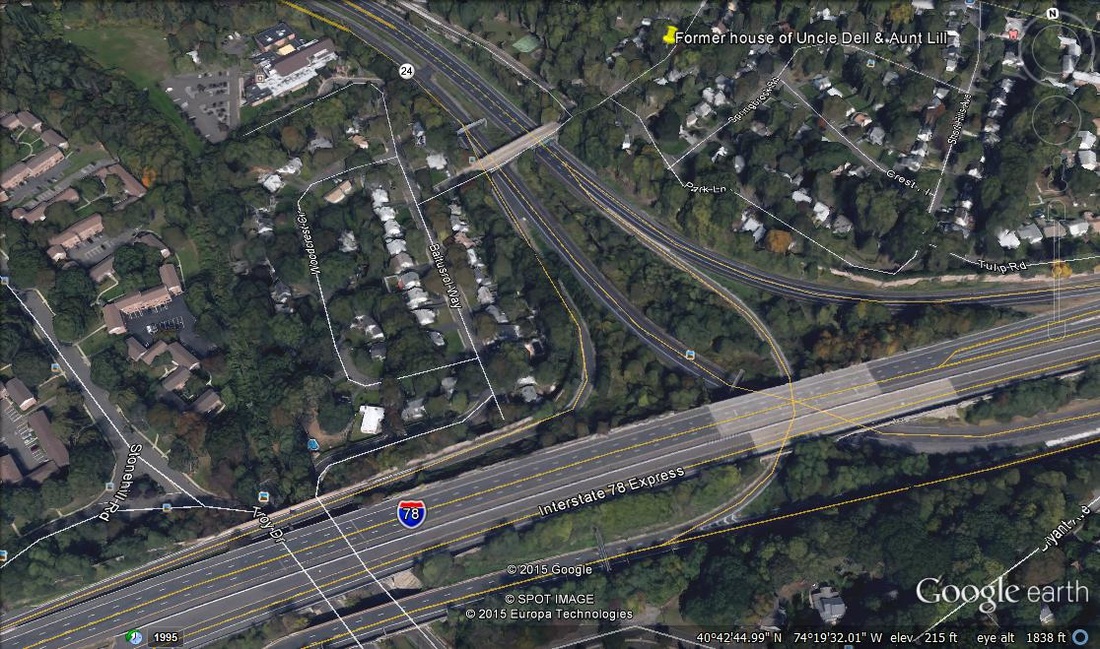 Another Google Maps image showing present day Baltusrol Avenue in Springfield, New Jersey. As Baltusrol extends westward, this is the area where the forest once stood, even extending down to where highway 78 now exists. Highway 24 now has overtaken this area. From Joni Mitchell: "They paved paradise and put up a parking lot!" I believe that construction took place around 1970 or thereafter. I don't think that Baltusrol Way or Woodcrest Circle were there in the Fifties or Sixties, and I don't remember Troy Drive or Stonehill Road being there either. Of course, my memory could be mistaken. An improvisational dance performed upon my vintage Patti Bros accordion, a 3/5 reed instrument in LMM configuration. This improvisational Valse is based upon the idea that dance is often spontaneous, expressive, and joyously alive. Although the title does not refer to an individual character specifically, I have never forgotten the enchanting cinematic roles played by several film-version Princesses from the 1940's. The first one I can remember is June Duprez who plays the beautiful Princess in Alexander Korda's spectacular fantasy film "The Thief of Bagdad" (1940), one of the most magical films ever created. Duprez is perfectly cast in this film opposite John Justin as Ahmad, with fantastic Technicolor production, a wondrous screenplay and dialogue, memorable cinematography, lavish set design & costumes, and fabulous special effects. Who can forget the magic flying carpet or the flying white horse or the Genie who appears out of the smoking green bottle? June Duprez looks absolutely lovely in this Arabian fantasy film, one of the all time great classics in cinema. The second image that comes to mind is that of Josette Day who plays Belle in Jean Cocteau's 1946 masterpiece "Beauty and the Beast." Cocteau directed this cinema classic with superb attention to detail, featuring marvelous set design and costumes, expressive music by Georges Auric, Henri Alekan's sensational cinematography and near magical integration of all elements. Josette Day captures the beauty of the story through her memorable portrayal of Belle, both repelled by and attracted to the Beast played by Jean Marais (Avenant/ The Beast/ Prince Ardent). Long after I watch this film, I simply cannot forget the astonishing visions captured within the heart of this fascinating fairytale. The third image that stirs in my memory is that of Moira Shearer in the 1948 classic "The Red Shoes," Michael Powell and Emeric Pressburger's sensational ballet film which features Jack Cardiff's brilliant cinematography, superlative art direction by Arthur Lawson, masterful production design by Hein Heckroth and memorable music composed by Brian Easdale. Moira Shearer illuminates the hard work and dedication of the professional ballet dancer, and she is aided by a superb cast of actors and dancers. Robert Helpmann created the choreography, with Sir Thomas Beecham conducting the Royal Philharmonic Orchestra in the ballet sequences. Moira Shearer as Victoria Page lights up the ballet stage, the silver screen and the intense drama of the unfolding artist's story. We sense the struggle between Art and Life, the contest between Boris Lermontov (Anton Walbrook) and Julian Craster (Marius Goring). Although ultimately a tragic tale, the marvelous beauty and artistic talents of Moira Shearer are abundantly displayed throughout the length of this fascinating film. Here is the majesty and the agony of the ballet dancer revealed and ultimately preserved for all who love the art of dance. Lyric Poema no. 2 per Fisarmonica Vintage - Lyric Poem No. 2 pour Accordeon Vintage - Affettuoso - Cantabile - Con amore - Con spirito - Dolce - Espressivo. An improvisation performed upon my vintage Patti Brothers accordion. Patti Bros accordions were produced in Italy by Lo Duca, with Patti's US headquarters based in Milwaukee, Wisconsin. Both companies are noted for assembling high quality instruments offering excellent reeds, superb fit and finish, beautiful tone and exquisite craftsmanship.
This accordion is a smaller instrument with a 16" keyboard but still offering the full 41 treble keys and 120 bass buttons of a full-size accordion. It features a beautiful baby blue color and remarkable appearance overall, with very fine quality parts and great attention to detail and craftsmanship. I find that improvisation allows the musician a full field of expressive language, moments which often surpass the joys of visual Art or the literary gifts we associate with the written word. This piece is a reflective song looking back upon some tender moments in my life, also offering those inner perspectives interwoven with remembrances of faithful friendships and everlasting love. An improvisation upon the theme of hiking in Arizona while exploring a canyon north of Tortilla Flat. Many years ago a friend revealed this site to me as we traversed the entire length and breadth of this natural corridor along the desert landscape. I would guess that the entire length of the canyon is several thousand feet, bordered by sheer walls which must ascend up to 400 or 500 feet. It had rained days before we made our journey and we discovered small rivulets of cool water which could barely be called a stream, lined with yellow-green lichen and moss, meandering through the floor of the canyon. There were pools of dark water which reflected the brilliant orange sunlight from above, giant boulders which you had to jump across, and an impression of ancient permanence in the majesty of this place. I recalled the mysterious beauty of Claude Debussy's "The Sunken Cathedral" as we hiked along the vast corridor stretched out before us. The area toward the south of the canyon opens up and allows a more spacious view of the surrounding desert landscape. When you climb back up toward the roadway above and then look down to see where you have been, you almost cannot believe the extraordinary depth and size of this area. It is truly a breathtaking journey well worth the time and effort it takes to fully explore this magnificent environment.
Performed upon my vintage 1930's Hohner Regina VI accordion, a 4/5 reed instrument in LMMM configuration. Two previous videos have featured improvisations which explore impressionistic themes associated with this canyon. "Lyric Poem for Accordion" posted 2/6/2014 with my vintage Iorio (video length 8:34) and "Fanfares & Reveries for Vintage Hohner" posted 9/13/2011 (video length 5:08) This video provides another example of what I call "painting with reeds" or imagining space, form, line, rhythm and color via the impressionistic music of a vintage accordion. Arizona is a special place for outdoor adventures including hiking, sightseeing and day-trips. Years ago I was brought face to face with an extraordinary canyon just north of Tortilla Flat, Arizona. A friend who once worked as a Forest Ranger showed me this location and we spent the entire day exploring the majesty of the Arizona landscape. Improvisation gives the musician an opportunity to record feelings and impressions which may otherwise be inexpressible or unsearchable. In this music I am recording both the majesty and the wonder of this remarkable area, utilizing the reeds of the instrument as my orchestra. There is often a pulse or breath of life which animates the scenery and vistas of a particular location, a sense of Divine handiwork which captures our imagination and may hold our interest for hours or days afterwards. In this case, I am remembering the vast perspectives and colorful details as seen from both below and above the canyon's corridors, as if the entire picture could be displayed via the textures and phrases of music. Manufactured in 1938, the Hohner Regina VI features a unique sonic signature which often reminds me of the power and characteristic versatility of a large pipe organ. I owe a debt of gratitude to my friend Jerry who tuned and restored this instrument, replacing worn parts and adjusting the inner mechanism to achieve remarkable results. Here is a 76 year old instrument which still speaks in a rather poetic and artistic manner, allowing the musician to "paint" via a set of extraordinary German reeds, providing a picture which remains indelibly etched in one's visual, tactile and sonic memory. Accordion Impressions: Along a Country Road An improvisation reflecting upon memories of a day hike along Possumtown Road in Piscataway Township, New Jersey in 1958 or 1959. My friend Bobby and I were Cub Scouts invited by the local Scoutmaster to attend a day hike with about 8 or 10 other Scouts along one of the country roads in rural New Jersey. We started out early in the morning on either a sunny Spring or Summer's day, traveling south to Cedar Avenue by crossing the railroad tracks of the Jersey Central and Erie Lackawanna lines and following the rural road to Possumtown Road where we began to travel eastwards along a two-lane country road heavily surrounded by densely wooded forests. It was a clear and breath-taking morning, dotted with wonderfully colorful scenes and crisp aromas of the country outdoors. We walked beneath a railroad overpass made of stone and steel and then continued our adventurous trek down this lovely country lane. Here and there were simple fields dotted with wildflowers, filled with butterflies, sometimes adjacent to crops and rows of tall corn bordered by tall weeds and the tangles of nature. We took great delight in the fabulous adventure of the day, enjoying the sights, sometimes slowing our pace to take in the abundant details spread so enchantingly before our impressionable eyes and senses. Across from an old stone house, someone had tied a small goat to a metal post. The little fellow greeted us with warm affection and we tarried just a moment to pet him and admire his quaint hideaway tucked next to the verdant wilderness. Somewhere down along the road, our leader asked us to pause and find a place to eat our lunches in the vicinity of a beautifully still pond strewn with rocks and green ferns. We took a well-deserved rest and enjoyed our hand-packed lunches, admiring the quiet stream and feeling the full nourishment of both the food and the spirit of the moment. When the time came to leave, we headed back the same way we had entered this lyrical domain, looking forward to begin our trek homewards and to share our adventures with our respective families. Today this area has been substantially changed, although Possumtown Road is still there in a four-lane version with a small length of the original two-lane design left in place. Now the vicinity is populated by light industrial buildings, commercial factories, parking lots and condominiums, all bordered by the fast-moving freeway known as Highway 287. There are some thickly wooded pockets of forest still situated along Possumtown Road, along with the remnants of a small pond and a nicely landscaped park. But the two-lane country road which we once traversed has been radically altered, probably no longer to be recognized through modern eyes.
Program notes: The opening theme begins at 00:14 and is quickly followed by a development section, continuing with still more development at 00:52 and the shift to stronger bass and a stirring sense of majesty at 01:26. The full master register sounds at 02:00 with a brief coda at 02:22. At 02:23 a quieter episode begins with the bassoon register, then the clarinet register at 02:44, leading to another quiet closing figure at 03:06. At 03:08 the violin register speaks, then the musette voice and a repeated development section. Further development takes place at 03:51, with the bassoon register bringing forth the lower notes in the treble section at 04:07 and a "walking bass" phrase displayed via the bass section. At 04:25 an introspective portion ascends to the fore, with the full master again introducing the original theme and development at 04:40. At 05:03 there is an impressionistic portrayal of climbing notes, as if one is reaching, walking, dreaming and marching all in continuous order. The ending portion begins at 05:21 with the closing chord heard at 05:31 until the final sounds fade away. Performed upon my vintage 1950's Scandalli accordion, a 4/5 reed instrument in LMMH configuration. The keyboard length is 17 inches. This accordion was given to me as a gift from friends around the year 2000. USA and Canada Copyright Disclaimer Under Section 107 of the Copyright Act of 1976, allowance is made for fair use for purposes such as criticism, comment, news reporting, teaching, scholarship, and research. Fair use is a use permitted by copyright statute that might otherwise be infringing. Non-profit, educational or personal use tips the balance in favor of fair use. This video is made solely for the purpose of study, review or critical analysis purposes only. I call this "Painting with Reeds" because I love the evocative sounds of these vintage Italian reeds. In the same way an artist would paint with a full range of impressionistic colors or in an impressionistic style, I find that the reed voices of a good accordion are capable of creating an atmospheric environment readily descriptive of an event, a person, a time, a mood, a specific setting or a range of ideas. 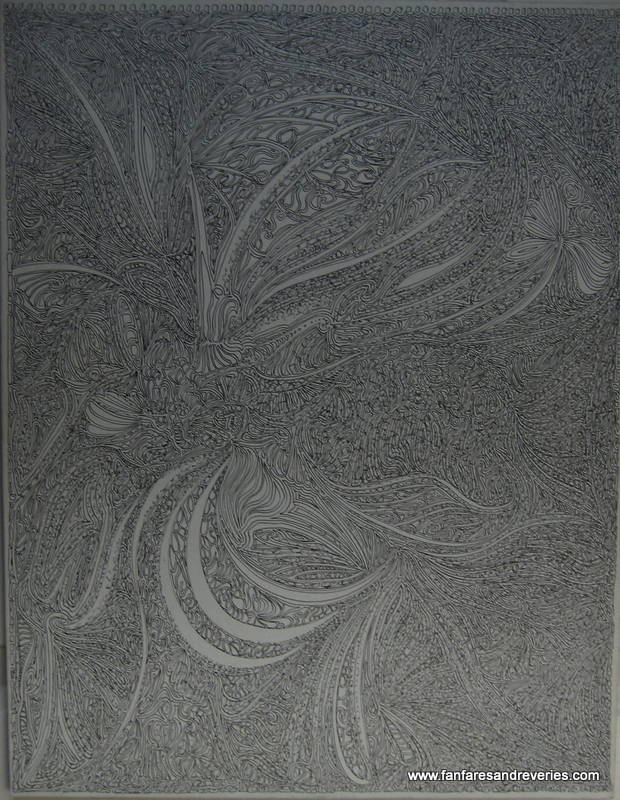 Pen & ink drawing, 15" x 19", on artist's board. Inspired by the many films and documentaries created by the noted French oceanographer, scientist, researcher & filmmaker Jacques Cousteau (1910-1997). The oceans of the world offer fabulous varieties of color, shape, form & intricate life. Artist: Glenn Tompkins |
Author
|
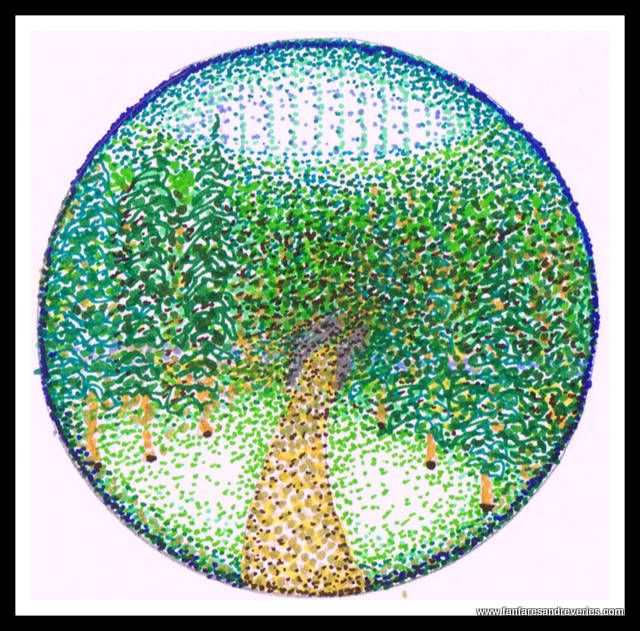
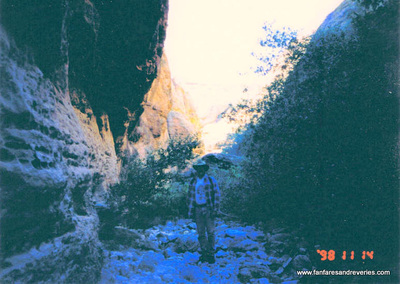
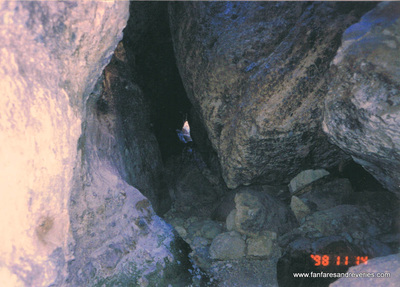
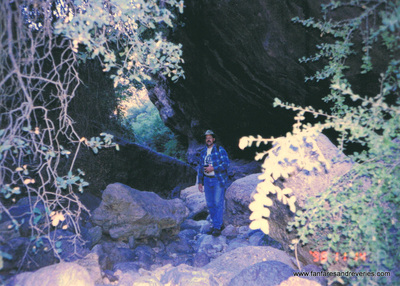
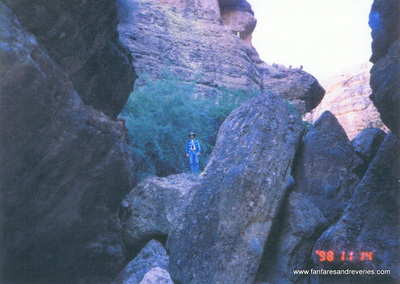
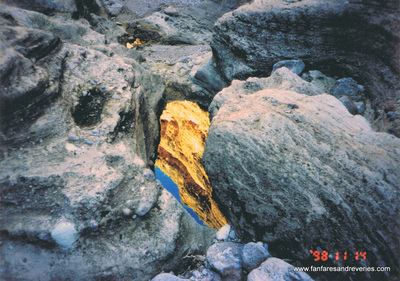
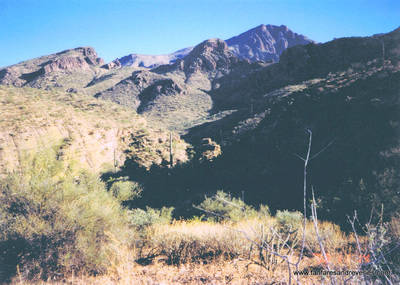
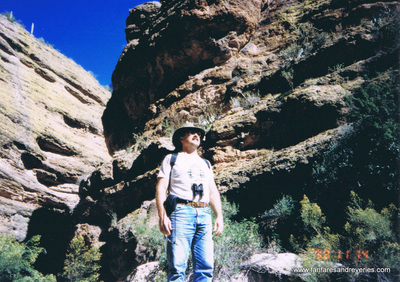
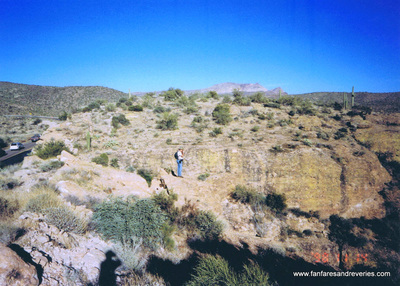
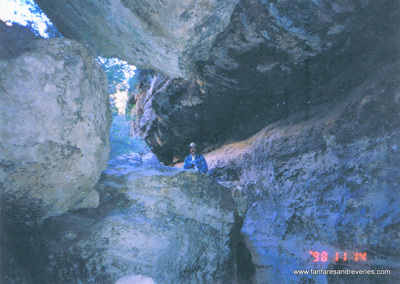
 RSS Feed
RSS Feed